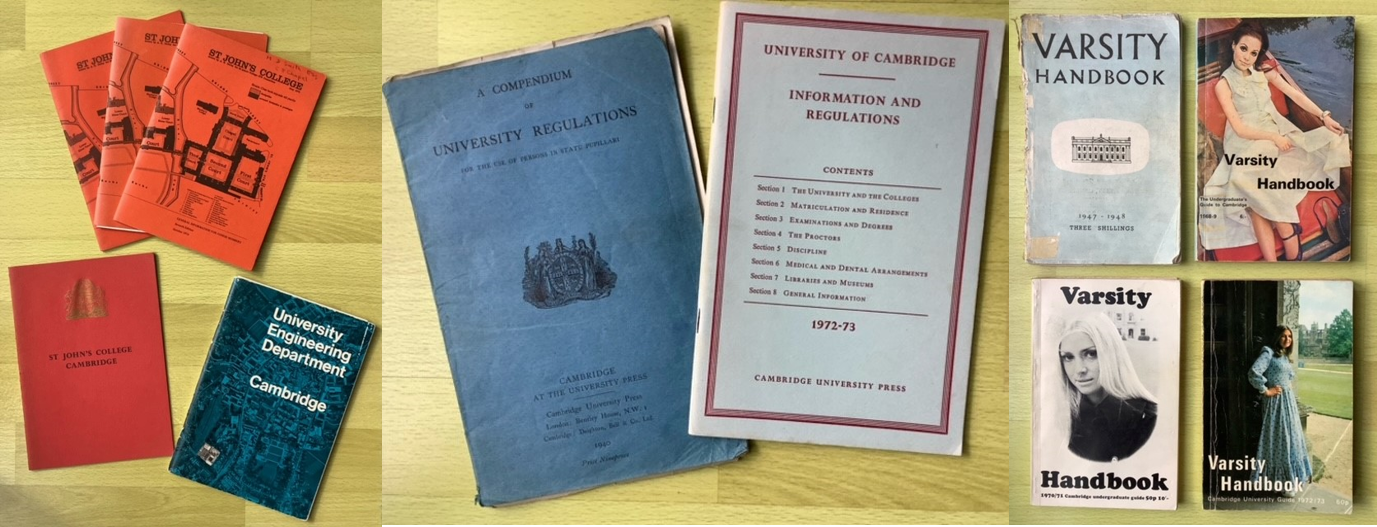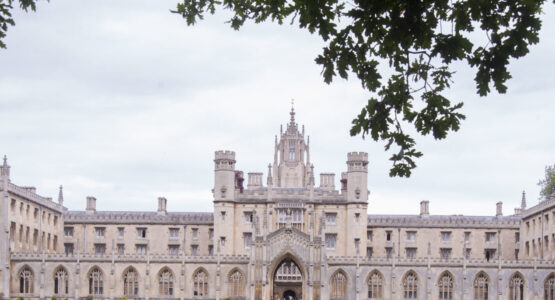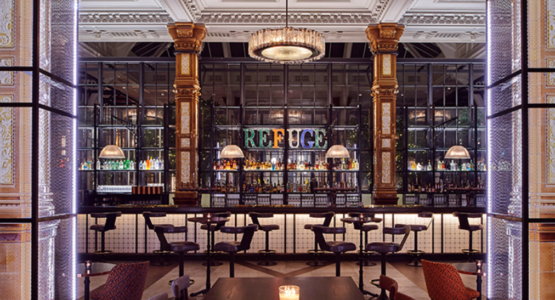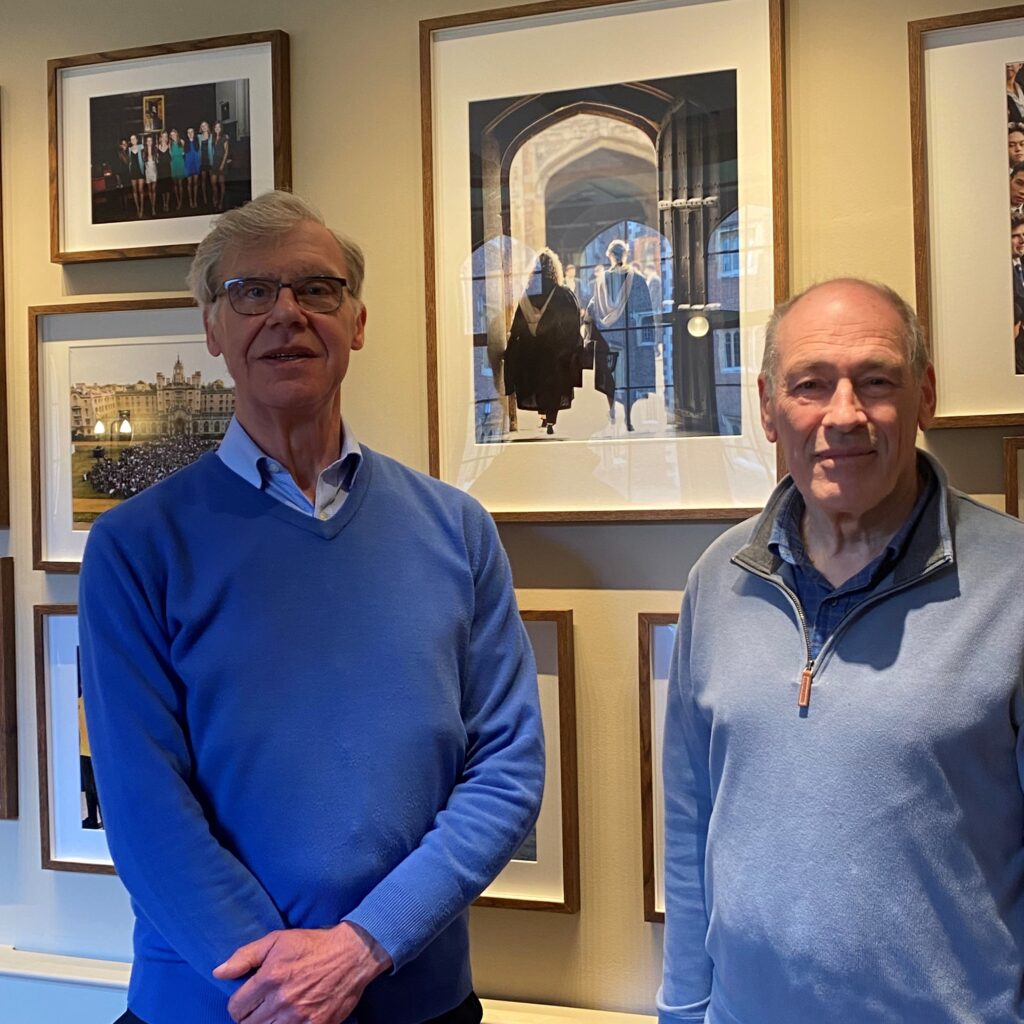
In September 2022 we welcomed back alumni who matriculated in 1972 for their fiftieth anniversary Reunion Dinner. Among the attendees were Mike Smith and Peter Stickland, who caught up with The Eagle Editor, Ellie Collingwood, to discuss what student life in College was like in the early 1970s.
During their time at St John’s, Mike and Peter studied Engineering and Natural Sciences respectively. Mike worked as a chartered civil and structural engineer and, while based at the Water Engineering and Development Centre at Loughborough University, he was Senior Lecturer and MSc Programme Director. Now retired, Peter qualified as a chartered engineer and worked in international consulting for the mining and metals industry.
Fifty years ago the College was a different place in certain respects, not least in the status of women and the funding of undergraduate degrees, yet it was facing some social and economic challenges that we might recognise today. In 1972, when Peter and Mike arrived here, strikes, protest and political scandals were a feature of the UK landscape. That year the College opened a new Buttery dining room for reasons that may feel familiar: the need to provide better-value options for students, and demand for greater informality and choice. There was a welcome rule change, too: women could now be admitted as guests in the new dining area, providing an opportunity for social mixing in the still all-male College. Having enjoyed the formality of College dining in Hall for their recent fifty-year anniversary, it seemed right therefore to bring Mike and Peter to the brand new Buttery, Bar and Café to sample our more informal offering.
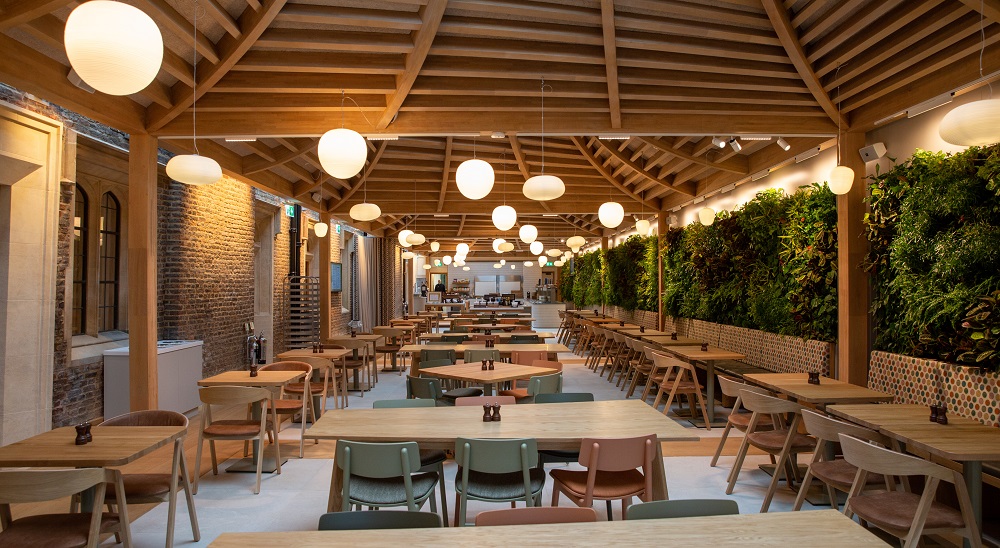
Sitting for lunch under the ‘green wall’ of the new Buttery, Mike and Peter admired the array and sophistication of culinary options now available to members of College. Although they enjoyed the food in their day, ‘the most exotic dish I can remember in the Buttery was beef olives,’ recalls Mike, ‘which were basically strips of beef wrapped around stuffing.’
Peter has kept the letters he sent home to his parents from that time, and they are full of details of eating in College, surely intended to reassure his family about his wellbeing. He wrote, ‘Hall food is good with no choice. Menu is published in advance. Much more convenient than cooking yourself.’ From another of his letters it is clear to see that the new Buttery of 1972 was hotly anticipated: ‘The new dining hall has not yet opened, the ceiling is slowly falling down… The new catering manager has been appointed and I have heard that one-day next week the majority of College is going in to breakfast to see whether he can cope.’
In later years Peter and Mike discovered the pleasure of preparing meals themselves, albeit in restrictive circumstances. ‘My roommates and I shared cooking a lot in the third year and did a lot of entertaining,’ Peter recalled, adding ‘we even entertained our tutor and his wife. We made a crab casserole from Katharine Whitehorn’s Cooking in a Bedsitter.’ Mike agreed that the classic book by the Newnham College alumna was an essential read for students attempting to impress with their culinary skills.
Our talk then turned to the other activities that Mike and Peter enjoyed during their time at St John’s. Like many Johnian students, they threw themselves into the extracurricular life of the University. They showed me their copies of Varsity Handbook and Braingrader, which provided a list of all the student societies. Peter especially remembers taking part in many societies and activities, telling me that at different times he was a member of LMBC, the Christian Union, the Chemical Society, Cambridge Union Society and the University Photographic Society. Peter remembers the first time the College got a dark room for developing photographs. For our meeting Peter brought with him a selection of large, black and white photographs that he had taken at the time, including very skilful reportage-style photography of protests on the streets of Cambridge.
As the conversation moved on to the pair’s academic life at St John’s, it seemed to me that their experience of studying would be quite familiar to many generations of Johnians – albeit with a few significant technological differences from today. Mike told me that one of the biggest changes he noticed coming up to university from school was that you had to find lectures yourself: ‘You had to buy the Cambridge Reporter which told you where lectures were and when they were.’ Peter added that the advice was to ‘go and read the notice boards’. The notice boards would tell you what was happening around College and the wider University. For unofficial news there were the student newspapers, Stop
Press and Varsity. It seems that little has changed in that respect, except that today’s students can also expect to be inundated with emails and social media content as major channels of communication.
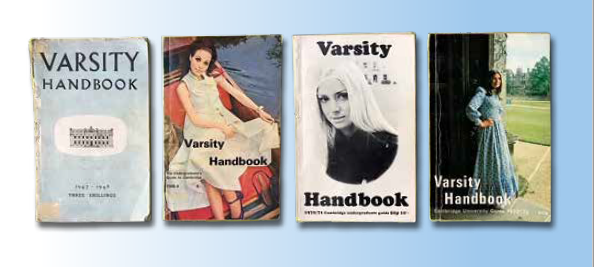
On the day of our conversation in the Buttery, Bar and Café, we were surrounded by many students working on laptops and tablets. Perhaps as a result of the pandemic, students have flocked to the new space to study – or at least use their laptops – side-by-side. I asked Peter and Mike about study habits in the early 1970s. Both said they usually worked in their rooms but sometimes went to their departments or the reading room of the Old Library for quieter study or for references. An alcove in the library reading room also housed one single electronic calculator, which Mike explains was chained down and could only be used in situ! In addition to the obvious modernisations, including computer access and internet provision across College, since Mike and Peter were students at St John’s the College has also had a new working library purpose built (1994). ‘I think the new library is really pretty good,’ Mike commented. ‘It’s much lighter and much more accessible.’
When I asked what else they thought had changed in the fifty years since they arrived in 1972, Mike quickly responded with ‘bathrooms!’ In the early 1970s there were no en-suite bathrooms for students, and Mike remembers a long journey from his bedroom: ‘In my second year I was in G staircase of New Court, and the nearest shower, toilet or bath was on E staircase. You had to go down from our room, across two staircases to reach the communal bathrooms and toilet cubicles.’ He reflected, however, that even that was an improvement from his father’s time at St John’s. ‘When my father came up in 1940, he joined LMBC partly on the basis that in the Boathouse you could get baths and showers. In College you couldn’t…’ Mike’s father also recalled that, while he was here in the 1940s, they put in bathrooms in the Fellows’ sets: ‘One Fellow took umbrage because he felt it was casting aspersions on his personal hygiene! He disappeared for several weeks because he was so offended.’
It was a privilege to speak with Mike and Peter and to listen to their stories of St John’s and a friendship that has lasted half a century. The Johnian reunion dinners are popular occasions for friends to meet together in College and enjoy its hospitality. See the current reunion schedule here.

